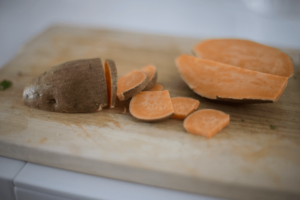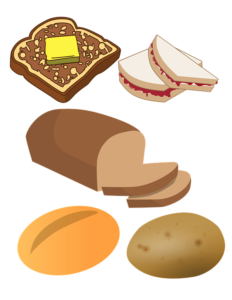In a previous post, I discussed the precarious support behind a high fiber diet. To briefly recap, a vast and unsupported assumption crediting fiber with colon cancer prevention fueled the “EAT MORE FIBER ALL THE TIME” mantra. However, I would like to add a caveat. Fiber may actually bear an extremely important relation to health, but it’s not about adding “bulk” or “cleaning out the colon” per se. Instead, it involves fiber as food for the gut microbiom e: all those awesome bacteria living in your large intestine which are ridiculously important for health. You live in a symbiotic relationship with these little buggers, so best take care of them!
e: all those awesome bacteria living in your large intestine which are ridiculously important for health. You live in a symbiotic relationship with these little buggers, so best take care of them!
This is what the whole “probiotic/prebiotic” thing is about: probiotics are the actual bacteria which benefit you, while prebiotics are food substances which feed these bacteria. And just as types of fiber can feed the gut flora, there’s another gut bacteria food (prebiotic) called resistant starch, which just may be the new black. Or Pink. Or whatever the saying is. It’s quite a complicated and crazy chemistry which I barely understand, but I shall attempt to break it down a bit. No pun intended. (A joke you will hopefully appreciate after reading this post.)
WHAT IS STARCH?

Let’s start by defining starch – the most common form of carbohydrate found in the standard American diet (shudder!) A typical “starch” is a carbohydrate energy source consisting of bonded glucose molecules in plants. Think “starchy” things like grains, potatoes, etc. Starches are high in sugar, and are specifically avoided on a Paleo diet. They raise insulin levels, spike blood sugar, enoucarage fat storage, etc. We resist starch around here!
Unless….
The starch itself is resistant. Say what?
Resistant starch is a type of starch which, due to one reason or the other (actually, 4) is not accessible in the normal digestive process of the small intestine. Instead, resistant starch is locked away, successfully making it all the way to the colon (or large intestine), like Frodo on the path to Mordor. In the colon, resistant starch feeds those good gut bacteria discussed above. How fun! In their feasting on resistant starch, these little guys produce short chain fatty acids (like one specifically called butyrate) which can fuel our bodies’ cells, and support the immune system. Happy gut bacteria = happy body.
THE 4 TYPES OF RESISTANT STARCH
RS1 (Nuts & Seeds) – This is resistant starch locked away in plant cell walls. You find RS1 in nuts, seeds, and whole grains. For Paleo, stick to the nuts and seeds.
RS2 (Raw) – This is resistant starch found in raw vegetables, due a large percentage of the “amylose” form of glucose (sugar) which is resistant to digestion, unlike the more easily digested “amylopectin.” You find RS2 in foods like raw potatoes and green bananas.
RS3 (Cooked & Cooled)- This is the crazy, cool one which sounds kinda fake and voodooy, but is actually scientific. RS3, or “retrograded starch,” occurs when you cook starchy foods, but then cool them completely before eating them. The cooking process frees up the starch to make it more digestible, but then cooling locks it away again. Think frozen Han Solo. You find RS3 in cooked and cooled potatoes, pasta, bread, legumes, and beans. So basically cooked and cooled sweet potatoes are what we’ve got to work with here.
RS4 (Fake) – RS4 starches are those which have been chemically modified to resist digestion. They’re processed. Ignore these.
RESISTANT STARCH BENEFITS
Adding some resistant starch to a Paleo diet may help keep the gut micro biome healthy and happy, and in turn support your immune system, energy levels, sleep, and health in general. Resistant starch may also help control blood glucose levels and insulin release. Oh, and it may encourage fat burning!
WHERE DO WE GO FROM HERE?
So, should you add some resistant starch to your diet? If you’re consuming a Standard American Diet, I probably wouldn’t worry about it. Not to be blunt, but your gut microbiome may need substantial fixing before you even worry about feeding it. You can support a nice gut flora by consuming probiotics and fermented foods, and cutting out all the processed and sugary foods feeding the bad bacteria.
If you’ve adopted a whole foods Paleo diet, however, your gut microbiome may be looking pretty dandy. This will be evident by good digestion and elimination, lack of digestive distress (gas/constipation/diarrhea, etc.), clear skin, and health in general. If so, you just may want to consider feeding the little guys by experimenting with some resistant starch. You can try this in the form of a tablespoon or two of potato starch (like Bob’s Red Mill Potato Starch,) or perhaps some cooked and cooled yams. Here’s an elaborate guide, although as you’ll see, most of the choices are NOT Paleo friendly.
Be ye warned! Initial supplementation may lead to a temporary increase in, shall we say, flatulance, as the bacteria produce gas as a byproduct from their new tasty meal. Also take note: I’m not saying eat grains, potatoes, and pasta (don’t let’s be silly!), but rather am advocating sensible supplementation with the resistant forms of starch discussed above. Embrace the green banana, and forget hot potato – we’re talking cool sensible yams around here 🙂
Resist on!

